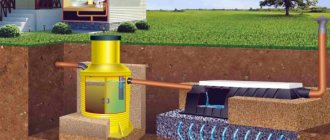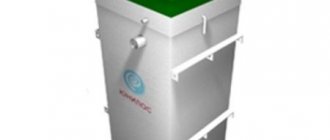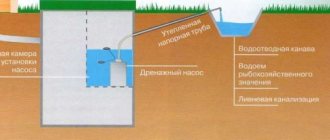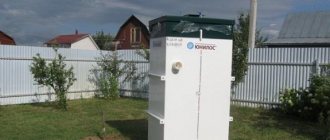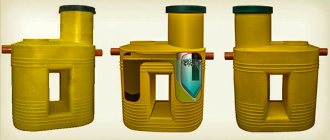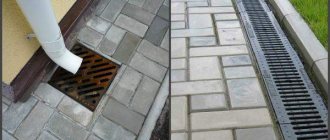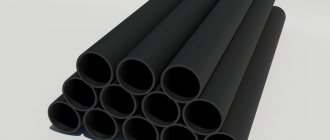What should you do with quicksand found in your own well? First, you need to understand what a quicksand is, what it can be, and only then begin to choose a method for solving the problem.
This natural phenomenon is a drifting area of liquefied soil, which will consist of clay and sand interconnected by larger particles. Under the influence of interlayer pressure, the mass supersaturated with water is able to move and spread. When encountering quicksand, diggers immediately begin to sound the alarm, but there are several effective ways to solve problems.
A natural phenomenon such as quicksand in a well can occur suddenly, so you will need to act without delay. If you first carry out the necessary geodetic research before constructing a well, you can find out the characteristics of the soil located on your own site. In this case, there should be no unpleasant surprises.
However, if the work has already begun, but geodesy has not been carried out, then the sequence of actions will need to be determined on site. Beforehand, it would be a good idea to familiarize yourself with the rules for constructing wells and the difficulties that you may encounter. Cleaning wells from quicksand should also be considered in advance if the lower threshold begins to rapidly silt.
What is quicksand in a well?
Quicksand is a layer of stuck together soil that is supersaturated with water. Its thickness can range from 1 to 15 meters. Often we are talking about a limited and slightly elongated volume, which is located in the thickness of the earth, filled with sandy loam and sand with the possible inclusion of larger and solid particles. If its condition is normal, then it will be stable and completely sealed. However, when exposed to it, quicksand can spread. If there is significant water pressure, the formation will begin to move rapidly.
The structure of such phenomena can be either heterogeneous or homogeneous, depending on the structure of the base (coarse-grained or fine-grained). Often the composition includes cemented masses and fragments of stones.
In hydrodynamic equilibrium, the mass will be located only at the depth of the well. In this case, the pressure created inside it will be balanced by the existing forces of the soil itself, which will be located underneath it. The mass can remain in this state for a long time until complete equilibrium is achieved. When opened, the internal pressure will become predominant, after which the sand will be pushed to the surface.
There are only two varieties of quicksand:
- False quicksand. The composition will include fine-grained sandstone supersaturated with water. If we take into account the depth of the formed mass, it will be in a state of excess pressure, which will help quickly push out the accumulated sand in the event of opening.
- A true quicksand. Based on the composition, in which colloidal dust-like and clay particles can be found, performing the function of a lubricant, they will be connected to each other using larger inclusions. Their filtration rate is incredibly low, so they can easily retain a certain volume of water inside themselves, not allowing it to leave the formed layer. Some swelling may occur throughout the winter. After drying, the mass becomes incredibly durable and hard.
Why is quicksand dangerous?
During the process of digging new wells, quicksand can appear at different depths and consist of solid fragments, sand and clay available on the site. It can occur at very different depths, so even specialists are not always able to accurately determine the location of its occurrence.
The main danger will be the high degree of mobility of the clay island due to the pressure created by the water. In this way, only erected walls, ceilings, hydraulic devices and structures can quickly collapse, and the soil can also subside significantly. In most cases, further construction of wells becomes impossible, since the installed rings begin to move independently.
Impact of quicksand on a well or well
The approximate depth of formation of quicksand in wells is 15-100 meters. However, this indicator is influenced by many extraneous factors. Pits, dips and ravines can also cause quicksand.
In an operating well, it can be located at the bottom of the chamber and begin to move only when exposed to water. However, the main reason for the occurrence of such situations is the presence at the bottom of both coarse-grained and fine-grained sand in the presence of a high level of ground flows.
The consequences may be as follows:
- complete or partial destruction of the mine and the hydraulic structure itself;
- the aquifer may disappear completely;
- soil heaving may begin at low temperatures;
- Water filtration will become insufficient.
Effective well cleaning
If you have already encountered a problem and poor-quality, contaminated water is supplied from the well, then cleaning the well from quicksand is inevitable. It is necessary to follow safety rules and also take into account the main points:
- When removing soil containing impurities from a borehole or well, do it in small batches to prevent rock collapse.
- To work inside the well, choose a dry season.
- Install an additional bottom filter at the bottom of the well.
How to clean a well standing on quicksand:
The problem can be diagnosed when cloudy, undrinkable water with a high content of sand begins to flow from the well. To filter sand, you need to install a filter made of wood, which is moisture resistant, at the bottom, making additional holes in the shield for water to escape.
To set up a bottom filter, you must follow the following steps:
- Remove excess sand, the volume of which is often up to 0.5 cubic meters.
- Place a half-meter-high gravel cushion at the bottom of the well.
- Prepare a wooden filter for a well in the shape of a circle and lower it to the very bottom. The resulting distance between the walls of the wooden filter and the walls of the well rings must be filled with broken bricks, and then filled with concrete grade no lower than 200.
Correctly performed installation guarantees that you will rise to the surface of water that is perfectly cleared of impurities and sand. It will be possible to pump it out with a pump.
What can the presence of quicksand lead to?
It is possible to get rid of quicksand in a well, but first you need to understand not only the reasons for its occurrence, but also the period of time that it has already been there. Not only the subsequent actions of specialists (owners), but also further manipulations aimed at preventing the formation of such masses and eliminating the identified consequences will depend on this.
If the problem arose relatively recently, the well has not been used for a long time, or a plot with such a well has already been purchased, you should pay attention to the fact that water can flow into the container, but this will happen extremely slowly. There may not be enough water at all for domestic purposes.
Volumes of water for domestic needs may be needed more than is available in the well, which will lead to rapid scooping out of the remaining moisture. In this case, it would not be a bad idea to seek help from specialists, since you will need quick and at the same time the most effective measures, the implementation of which will require expensive specialized equipment and some experience in carrying out such work.
If the flow rate of a well has only recently begun to decline, and the well itself was built relatively recently, it is necessary to restore the flow of clean water as soon as possible by completely removing the obstacle from the selected structure. However, for each specific case you will need your own measures to solve the problem.
Water intake design: what to choose
From all of the above, it becomes clear that when building wells you have to fight with true quicksand. The larger and more powerful it is, the larger the scale of measures taken to ensure that the water intake is not only built, but can subsequently function normally.
So:
- You are faced with the need to combat this unpleasant phenomenon not only in the process of passing through quicksand when digging a mine. It can clog the water intake part of an existing well, which was previously operated without problems, and then its shaft will have to be deepened.
- Before you start building a well, you need to try to collect information about the nature of the soil on your site. The easiest way is when your neighbors have a well. If there have never been problems with quicksand, then there is a high probability that you will not have to deal with it either.
- By the way, by looking at the neighboring water intake you can find out at what depth the groundwater lies. If there is no such well nearby, there is another way out - exploratory drilling. Organizations involved in the construction of wells also provide such services to the population. The price of an exploration well does not exceed 12,000 rubles.
- If reconnaissance has shown the presence of true quicksand along the excavation route, it is better to abandon the construction of a mine well. The right choice in such a situation would be an Abyssinian well, which can be built with your own hands. In a more expensive version, it can be a well in the sand, equipped in compliance with all technologies, by a specialized team.
Homemade Abyssinian well
The tube well has such a small diameter (2.5-5 mm) that the soil, in fact, is not drilled, but pierced with a rod with a sharp tip. Therefore, the Abyssinian well has another name: needle well.
Mini-drilling rigs are used for its construction. To get through quicksand, drilling is done inside a metal pipe using the percussion-rope method - this applies to all types of wells.
How to pass quicksand
Overcoming quicksand on your own can be very problematic, but it is quite possible. If you have decided to get rid of the problem yourself, you should weigh the pros and cons several times before taking specific actions.
Digging wells on already formed quicksand is not only a difficult task, but also very risky. Even if everything went smoothly, significant strengthening of the base (bottom), subsequent use of bottom filters and regular maintenance of the structure will be required.
Bottom filter
However, even such a thorough approach to the situation cannot guarantee a solution to the problem, and after some time the problem may return. Quicksands change their speed of movement independently.
There is no guarantee that a small layer of sand will not begin to move independently at incredible speeds after years. However, if there is no other way out, and the need for a well is enormous, then you can use the following methods to solve (localize) the problem:
- arrangement of a well in the selected well;
- digging a well.
Abyssinian well in quicksand
One of the most successful, and therefore popular, methods of combating quicksand is the development of an Abyssinian well.
Construction of an Abyssinian well
This method is the development of an existing source through the operation of a well. In most situations it is customary to use this method. This is due to the fact that passing such a tangible obstacle is quite problematic. To begin with, the quicksand is cut through its entire depth, and then the casing pipe is installed. Next, you will need to properly secure the installed pipe, plug it and strengthen the bottom of the tank in every possible way.
Installation of an Abyssinian well
This method is characterized as effective and at the same time reliable. The difficulty is that you will need to additionally install the pump on the casing pipe. For this purpose, preference is given to equipment that does not belong to the category of submersible and vibration models, although they are characterized as resistant. Surface samples will be needed, which require additional protection and regular maintenance. This type of equipment is capable of operating with wells whose depth exceeds 8 meters, which can cause some inconvenience.
Abyssinian well
We pass the quicksand, digging a well further
In this case, we are talking about a significant deepening of the existing mine. It is worth noting that this activity is very labor-intensive, but can be done by any person who has a huge amount of free time. By using already developed methods, the work process can be significantly simplified.
This method has its own characteristics:
- concrete rings are fastened together;
- using a tongue and groove during the digging process.
The tongue and groove is a prefabricated wooden structure, for the manufacture of which it is customary to use strong timber. It will be necessary to pass through a small quicksand (insignificant layer).
To assemble the tongue and groove, metal plates and boards knocked together are used. The lower part will consist of pointed teeth. Outwardly, it looks more like a hollow drill. The sheet pile must be deepened several meters. Afterwards, sand and soil are removed from it. The structure of the quicksand is incredibly soft, more reminiscent of swamp slurry, which will allow you to easily push the mass using a tongue and groove.
Passage of quicksand using the sheet piling method
Work should continue until the construction team reaches a certain depth. Concrete rings are used only when the quicksand is weak, moving slowly and thick enough. In this case, the negative consequences will be minimal, and the work will take place according to the same scheme under the same conditions. The rings will also be clogged to prevent them from coming apart during use. This way you can create a truly monolithic structure.
What problems arise
Problems with the presence of quicksand can arise during the construction stage and during the operation of the well. In the first case, difficulties arise if such a layer is located in the place where the well shaft is being dug, and it needs to be crossed, i.e. when the condition arises: the quicksand is located above the aquifer.
When digging a pit, you have to open the quicksand, which causes it to move. The liquefied mass begins to fill the shaft, making it impossible to deepen it further. The forming cavity leads to a high probability of displacement of soil layers.
Thus, a mandatory requirement arises: work on digging a mine can only take place if the walls are secured and the quicksand is blocked.
Big troubles arise during operation when the quicksand is located in the bottom zone of the well . In an existing structure, this phenomenon primarily pollutes the water. However, this is far from the biggest problem. Quicksand impedes the flow of water and, in principle, can lead to complete depletion of the well.
In addition, possible mechanical loads cause great danger. In the lower part of the well there is a risk of lateral shift or settlement of concrete rings or frame crowns. When the formation freezes in the middle part of the shaft, intense swelling occurs, which creates very high loads on the shaft walls. In other words, an existing well in quicksand puts forward such increased requirements: periodic cleaning of the bottom zone, strengthening measures, etc.
How else to get rid of quicksand
The question: quicksand in a well - what to do, can be answered in different ways. However, there are additional ways to solve the problem that are known to many, but they are used only in special cases.
So, you can build a metal box or a full-fledged filter. Using a box, you can significantly increase the safety indicator of the entire structure and ensure the necessary purity of process water. However, it is made without a bottom. The sides are made as sharp as possible so that it is easy to cut them into the thickness of the soil during installation. The presence of such a metal structure will influence the final volume of transported sand masses.
The visible element of the well, located outside, must be equipped with a small hatch. It will be needed in order to be able to independently clean the well tunnel if the blockage reoccurs.
Before placing the metal container, it is necessary to further strengthen the walls of the well. For this, clay or a special solution is used. A displaced sand level will not produce water of high quality and without impurities. In this case, it is recommended to give preference to a bottom filter. Small grains of sand will always rise to the surface of the water. This makes the liquid a little cloudy and unsuitable for consumption, either for food or for solving technical problems. However, installing specialized equipment will not give the required result. The pumps will quickly become clogged with fine sand.
To avoid such situations, you should make sure you have a really high-quality filter. It is preferable to use a material such as wood (moisture-resistant species). Experts prefer aspen boards. They get together, forming a full-fledged shield. Its size should not be larger than the diameter of the well (its tunnel). A difference of a few centimeters will be more than enough. The shield should not have large holes or cracks. The holes responsible for the water supply are made independently.
Aspen bottom filter
A self-assembled filter will have little weight, so lifting it up if necessary will not be difficult. It is secured at the bottom with stones. Such a shield must be replaced every five years, as the structure begins to rot and loses its original properties.
Prevention measures
If the well is located on such an obstacle or has approached it over time, which is fraught with clogging, you should pay attention to the following important aspects:
- Even for cleaning, you should not completely pump out water from the well.
- The free space will be occupied by quicksand, which will be problematic to completely pump out.
- The height of the water column will not matter much.
- The water efficiency indicator will always be at the desired level.
- Installation of water filters should be carried out exclusively at a horizontal level (water-bearing level).
- The sludge should be scooped out regularly.
- The bottom of the well must be additionally reinforced with a board and logs.
- Systems are cleaned every five years.
To avoid problems in the future, before constructing a well, you need to make sure that there are no quicksands in the selected area. If there are wells nearby (neighbors), you should check them for similar problems. In addition, all necessary geodetic work should be carried out, because quicksand in a well is a common problem. If the barrier is too mobile, the arrangement process should be stopped completely. Otherwise, the equipment used will be completely destroyed. Particular attention should be paid to wall insulation.
Useful tips and tricks on how to remove it
If there is no other source near your site, it is better to carry out test drilling by hand to identify quicksand.
The work is carried out with a hand drill, reaching a depth of 15-20 m. By carefully studying the soil being removed, it is determined when the drill entered the float. After that:
- Based on the number of installed shafts, they determine the level at which the floater is located, the size of its body, and the depth of the aquifer. Based on this data, they decide what type of well will be built;
- if a small amount of impurities is found, and under them there is an aquifer no more than ten meters from the ground, they choose the option of constructing a tube well. In case of deeper water, a well should be drilled.
If you started constructing a mine without exploratory drilling and found quicksand, in this case it is difficult to determine the thickness of its body and make some kind of informed decision. Another situation may arise - water began to disappear from a long-used well. Its quality began to deteriorate, and the source began to become shallow over time.
The solution to these problems is to drill deep into the well. The cost of the work will be lower, since it is not carried out from the surface. Pumping equipment will then be installed in the mine.
